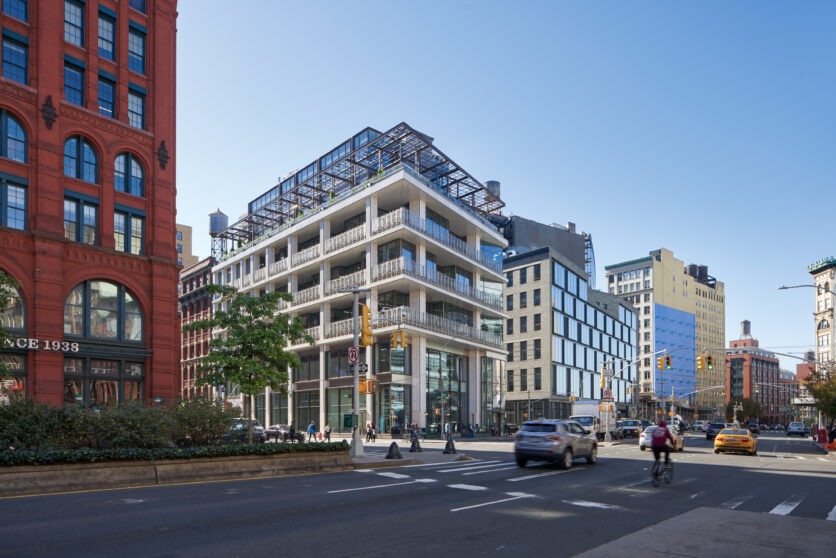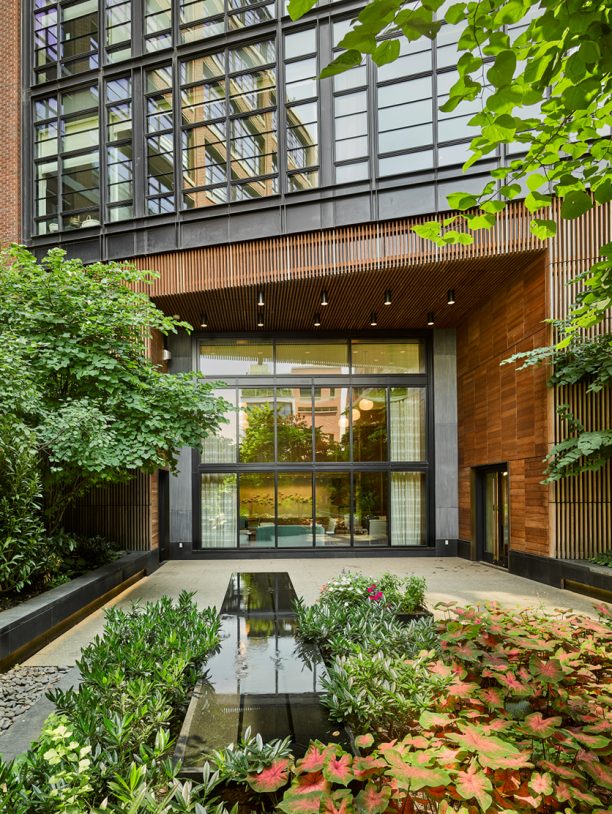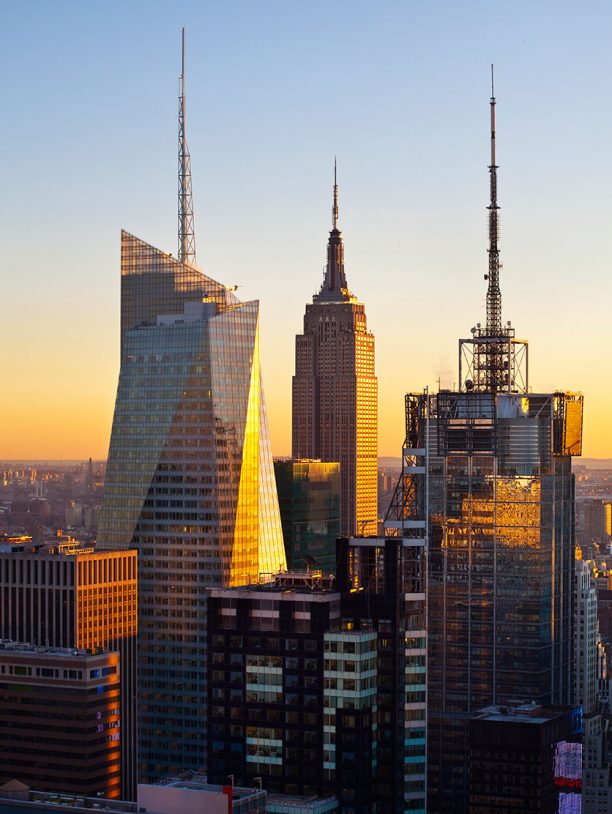The Fifth Façade: Designing Nature into the City
Rick Cook and Jared Gilbert – CTBUH
New York’s most iconic buildings, the early 20th-Century high rises—the Woolworth Building, 70 Pine, Rockefeller Center, for example—were designed as aspirational symbols of urban life defined by power, wealth, and capitalism, yet also carefully sculpted forms that mediate between the great height of the structure and life at street level. These stepped skyscrapers created a “fifth façade” of roofs, terraces, and balconies that took advantage of daylight, natural ventilation, and preserved views. In New York City designers today are introducing building forms that can be seen as contemporary interpretations of the materiality and language of these early high rises and rediscovering iconic sculpted forms to integrate nature and natural processes into the built environment. Inspired by biophilic design, the fifth façade is now being reimagined as green, productive space that integrates nature into the urban environment, mitigates the effects of climate change and enhances the health and well-being of the City.
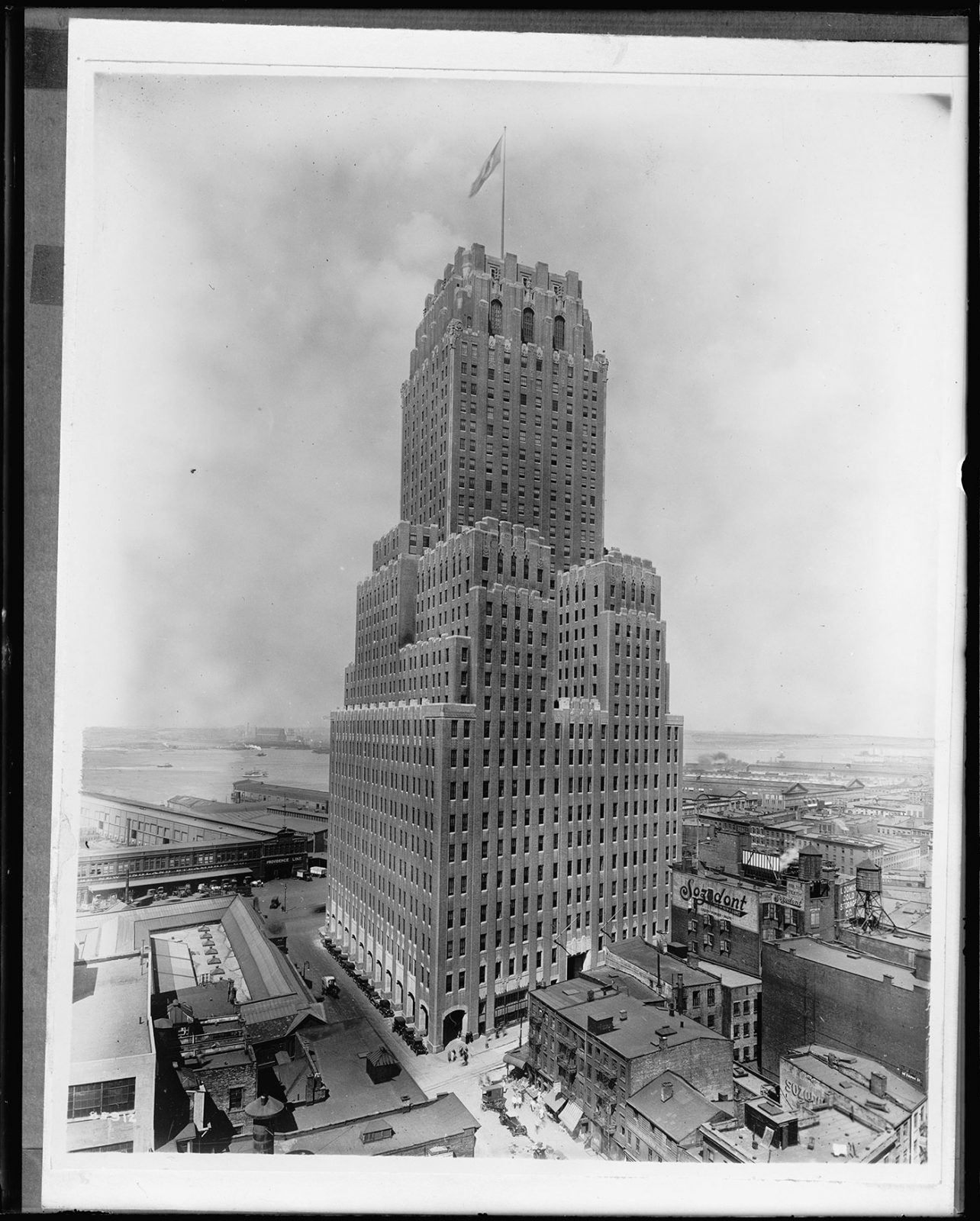
Tall Buildings in New York
New York’s “race to the sky,” precipitated by an unparalleled economic boom and advances in building technology, produced many of New York’s most enduring architectural icons. Writers and artists of the time assigned biomorphic qualities to these technical and mechanical wonders, and the popular imagination assigned them monumental status as mountain peaks and cathedral towers.
The tall building in New York has always been emblematic of the city’s most powerful ambitions, wealth, culture, and sophistication. These towers were also in constant tension with public sentiment. A Real Estate Record and Guide article of the era proclaimed these towers an “Invasion of New York City by Darkness.” (Robert A. M. Stern, 1983, p. 169) The construction of the gargantuan, sky-hogging Equitable Building famously catalyzed the first zoning regulation in New York to protect access to light and air. The idea that access to the sky was a shared resource pushed urban policy makers to create sky exposure planes that resulted in the dramatic peaks of the New York skyline, including the American Radiator Building, Standard Oil, and numerous stepped monuments that emerged under the new zoning during the Art Deco era. Among the best examples of the era is The Barclay-Vesey Building (fig. 1), completed in 1926 by Voorhees, Gmelin and Walker at 140 West Street. The tower rises ten stories from a base building that fills an entire block. Its form sets back to create huge terraces that subdivide the building mass into smaller components, create additional vertical façade area to add daylight to the interior, and reduce intrusion of the building into the sky view from street level. The 1927 Fred F. French Building (fig. 2), designed by Sloan and Robertson at 551 Fifth Avenue, rises from a large base of eleven stories and through a series of terraces distributed over eight floors, tapers from the street to a slender profile. The setbacks were staggered to create additional corners and window area and add daylight to the large floor plates. The thin tower sets back again at the top, to minimize the intrusion into the sky and accentuate its height.
The early skyscrapers were not yet concerned with nature as an asset because notions of urban power were represented by the machine aesthetic—although plenty of detailing from the era included literal and natural-analogue forms. However, their articulated façades were in part practical responses to provide interior spaces with increased daylight and natural ventilation. The decorated forms that receded upward were beautiful cathedral-like spires that the public could share; nostalgic symbols of cultural achievement and celebrations of the modern city’s cultural dominance.
Post-World War II design brought dramatic change to the skyscraper. The war had mechanized much
of American culture and designers in cities came to prioritize cost efficiency, power, and most crucially, precise control of the interior environment. Buildings reduced natural externalities to accommodate universal solutions of efficiency. Stepped and tier towers that took passive advantage of daylight and natural ventilation became tightly sealed glass and steel boxes, as air conditioning and fluorescent lighting became ubiquitous and did the work. A building that did not have to balance the vagaries of climate opened up new possibilities for large expanses of glass, vast floor plates and new models of corporate efficiency. Within single-glazed façades, environmental efficiency was hardly yet a concern. The new curtain walls were modern and technically advanced, and increased access to daylight at the perimeter. Post-WWII modernist architecture sought design purity and efficiency with repeat forms. Massing came to be organized by efficiency of the façade and floor plate, and towers that previously sat at the street, sculpted back to afford light and air, now fronted vast plazas opening up the streetscape to public use. Of the finest examples, Lever House at 390 Park Avenue by Skidmore Owings and Merrill’s Gordon Bunshaft, disrupted the tall street wall of Park Avenue by turning its tall thin tower away from Park Avenue and lifting the base to create a partially covered garden plaza at street level and a planted terrace above introducing open space and light into the densely developed area.
Eventually, the need to reduce the operating costs of the modern buildings further separated occupants from the cycles of nature. The next generation of towers introduced reflective and tinted glass that dimmed access to daylight. The ultimate outcome to the modern skyscraper era was a sealed monolithic form that was impenetrable to the environment.
In The Tall Building Artistically Reconsidered, Ada Louise Huxtable provided a strenuous argument against the exploitation of architectural forms that reduced the skyscraper to mere blocks of thinly wrapped commercial space designed with the singular function of making money. She lamented the imposition of skyscrapers on street life, access to sky and sunlight, livability and most critically their burden to “the city’s antiquated support systems, circulation, and infrastructure.” (Huxtable, 1984) Hers was an aesthetic argument for a momentary boom time in New York building, but her points are ever more valid today. The 21st-Century has brought new attention to sustainability and resiliency, and the concerns of urban life are merging with issues of climate change, and greater consciousness of health and wellness in the built environment.
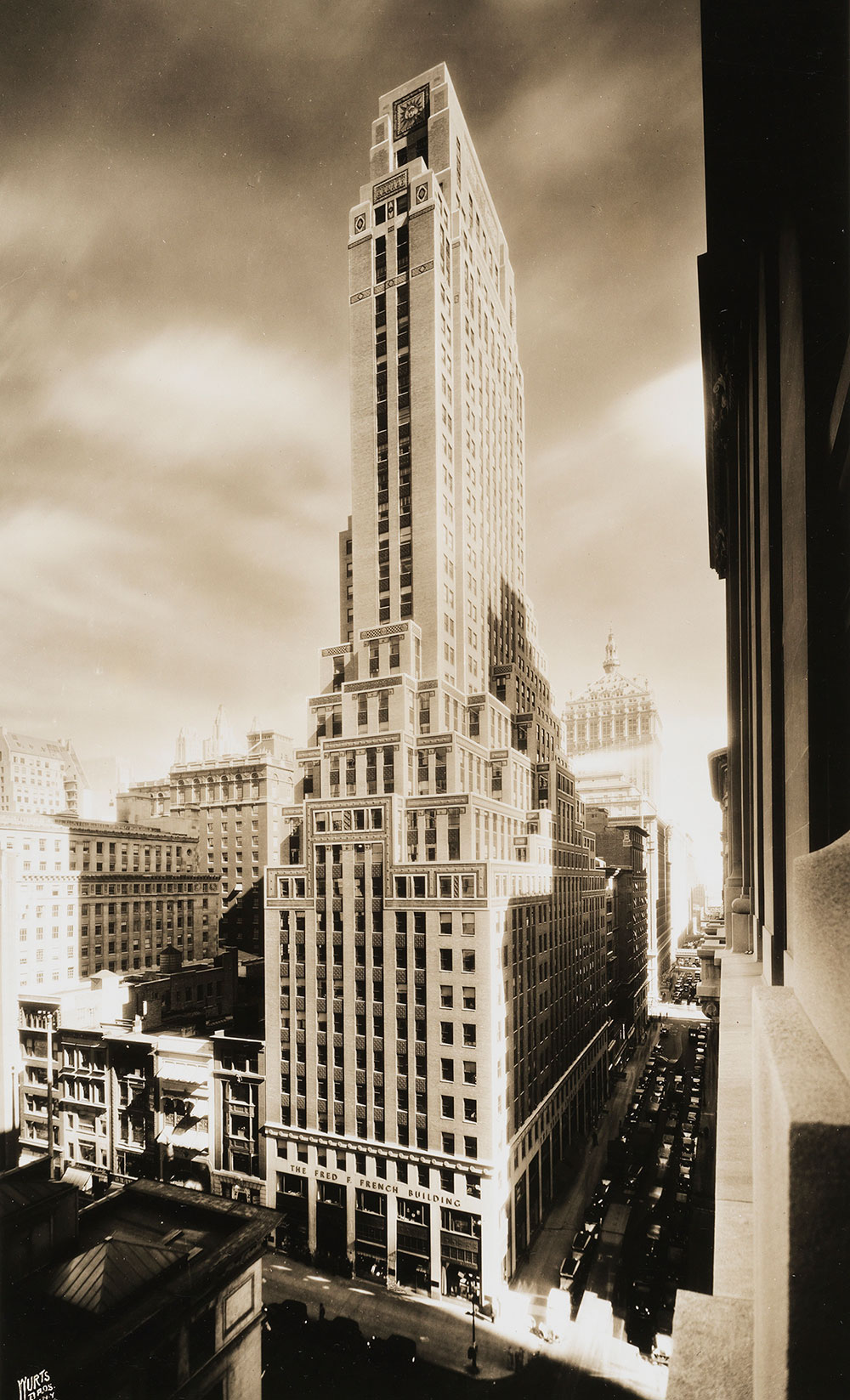
Nature and the City
In his book Designing with Nature, Ian McHarg argues that urban design should be subject to the regulations informed by natural processes, just as buildings are required to meet safety regulations. McHarg’s concern was providing enough open space to allow productive ecological services. In his view, ecological functioning should not be confined to conservation areas, greenbelts and large parks, but must be accomplished through an “interfusion of open space and population.” (McHarg, 1969, p. 57) In considering urban development, the value of the potential for natural process on the site must be factored into the value of the development and enforced by policies informed by nature. As McHarg writes, “Principles should be constructed into policies that will ensure that the resources of the city, site and artifacts, are recognized as values and determinants of form, both in planning and execution of works.” (McHarg, 1969, p. 176).
In considering the value of ecosystem services and real estate, developments must also consider less tangible value in creating open space for natural processes, including the biophilic benefits of human interaction with nature.
Science of Well-being
Design inspired by the concepts of biophilia is becoming central to the work of architects concerned with creating healthy workplaces and living spaces. Decades of research reveals how health and productivity are tied to variances in air temperature, humidity, and airflow, access to water and frequent changes in the brightness, color and quality of light are critical to optimal human functioning. Research also shows that workplaces with views to nature produce measurable increases in productivity. Health benefits of interaction with nature include significant reduction in stress levels and anxiety, which are tied to a range of physiological and mental health disorders, including heart disease and depression. Exposure to daylight provides benefits to neurological and immune system functioning. A report entitled The Economics of Biophilia cites broad benefits: “Case studies have documented the ad-vantages of biophilic experiences, including improved stress recovery rates, lower blood pressure, improved cognitive functions, enhanced mental stamina and focus, decreased violence and criminal activity, elevated moods, and increased learning rates.” (Terrapin, 2012)
The Fifth Façade
Landscape Architect Diane Balmori has repurposed the term “Fifth Façade” to describe the landscape potential of the urban roof-scape. The term, which began appearing in the middle of the 20th Century to describe the architectural potential of roofs, is now a descriptor of the green potential of the roofs. Just as the vertical façades of a building are a shared public surface in a densely urban environment, the roof-scape is also shared. The concern is not merely aesthetic, although a beautifully landscaped roof is certainly preferable to a hot bubbling black tar surface. Introducing natural landscape to the fifth façade yields significant benefits to the urban life: reducing storm water run-off, production of oxygen, producing habitat for native species, reduction in heat island effect, increased thermal performance of buildings, and productive surfaces for food production and recreation. The ability to reknit the ecological fabric of a city to create healthier, more sustainable and resilient cities through the planting of the roof-scape is emerging as a primary driver for planners, architects, and developers.
Resiliency & Mitigation
In the aftermath of 9/11, and the economic downturn that ensued, urban planners, policy makers and the public began to explore how to remake the city to be healthier, safer, and more resilient. The Bank of America Tower at One Bryant Park, by COOKFOX Architects, provided a crucial turning point as one of the first skyscrapers built in New York after 9/11 and the first LEED Platinum skyscraper. The tower represented a new typology of building that incorporated features that not only made the tower more sustainable and resilient, but it began to redefine how buildings could interact with the city ecology and urban life.
Its crystalline form shares the aspirational reach of early skyscraper icons, but the form is most efficient in its ability to maximize access to daylight and views within the office floors. The building’s owners sought to build a building that would attract and retain the best talent, which demanded spaces that provide a healthy, productive environment with the cleanest air, biodynamic lighting and access to views to nature. At the tower, 90% of employees have views to parks, green roof, or rivers. At ground level, a public Urban Garden Room incorporated into the lobby extends the natural setting of Bryant Park into the building, providing all-weather connection to nature to pedestrians.
The tower utilizes storm water and groundwater flowing from ancient underground streams to supplement non-potable and cooling tower water uses in the building, reducing stress on New York’s aging water systems. An on-site co-generation plant produces enough power to handle the base building load and ice storage tanks provide cooling to the building to reduced energy use when the city’s electrical grid is most stressed. Green roofs are a critical link in our city’s green infrastructure to mitigate the effects of storms, by allowing buildings to absorb, retain and filter storm water, reducing impacts on the sewer system. At One Bryant Park, a green roof with apiaries fills the space between the tower and its neighbor at 4 Times Square, reducing the urban heat island effect, improving localized air quality, and adding to a growing network of green spaces in Midtown that are knitting back together its ecological functioning.
Adaptability
Our planet is rapidly urbanizing, with a majority of the earth’s inhabitants already living in cities, and 70% of the world’s population projected to be urbanized by 2050. The health of cities—and our species—depends on our ability to create healthier urban environments. Ensuring delivery of clean water, and transforming our food systems to provide more reliable, more nutrient-dense fresh foods to urban populations. In New York, where farmable land is at a steep premium, the fifth façade can be an important part of a distributed food production system that is more resilient to disruptions of climate change.
In Brooklyn’s bourgeois neighborhoods, community gardens have years long waits for membership and gardening is an art form, producing an urban farming infrastructure that is starting to change the way average New Yorkers can acquire healthy vegetables. In New York’s poorest neighborhoods where fresh vegetables are not available or are priced out of reach of most residents, the need for urban agriculture is urgent. These same neighborhoods are some of the most vulnerable to flooding during storms and even during regular rain events. Grassroots community grounds have responded creatively developing programs to help neighbors rebuild gardens on terraces and roofs and areas that are safe from flooding, and teaching them how to grow fresh vegetables successfully in alley ways, roofs, window ledges and other found space. New affordable and supportive housing are beginning to incorporate planted spaces, with accessible terraces, deep façades that incorporate window planting boxes, and farmable courtyards.
In 2006, the winning entry for the New Housing New York affordable housing design competition, designed in partnership by Grimshaw and Dattner Architects, included an architectural rendering of a grandmother and children harvesting vegetables from a rooftop garden atop the proposed design. The building form incorporated a cascade of terraces for planting. The image captured the imagination of planners and the public, spotlighting the notion that a building’s roof-scape should not only be planted for ecological services, but could contribute to the quality of life by feeding its residents. In its first growing season, the gardens produced 1,000 lbs. of fresh vegetables. (GrowNYC, 2015)
Rooftop farming is not new, but in the densely urbanized confines of New York City new buildings that incorporate farming are only beginning to emerge. Large scale rooftop farms, such as the Brooklyn Grange, have sprouted on big footprint buildings and are leading the way in developing sustainable models for distributed food production systems. Small-scale experiments are helping designers understand how to design food production into new and existing buildings of differing scales.
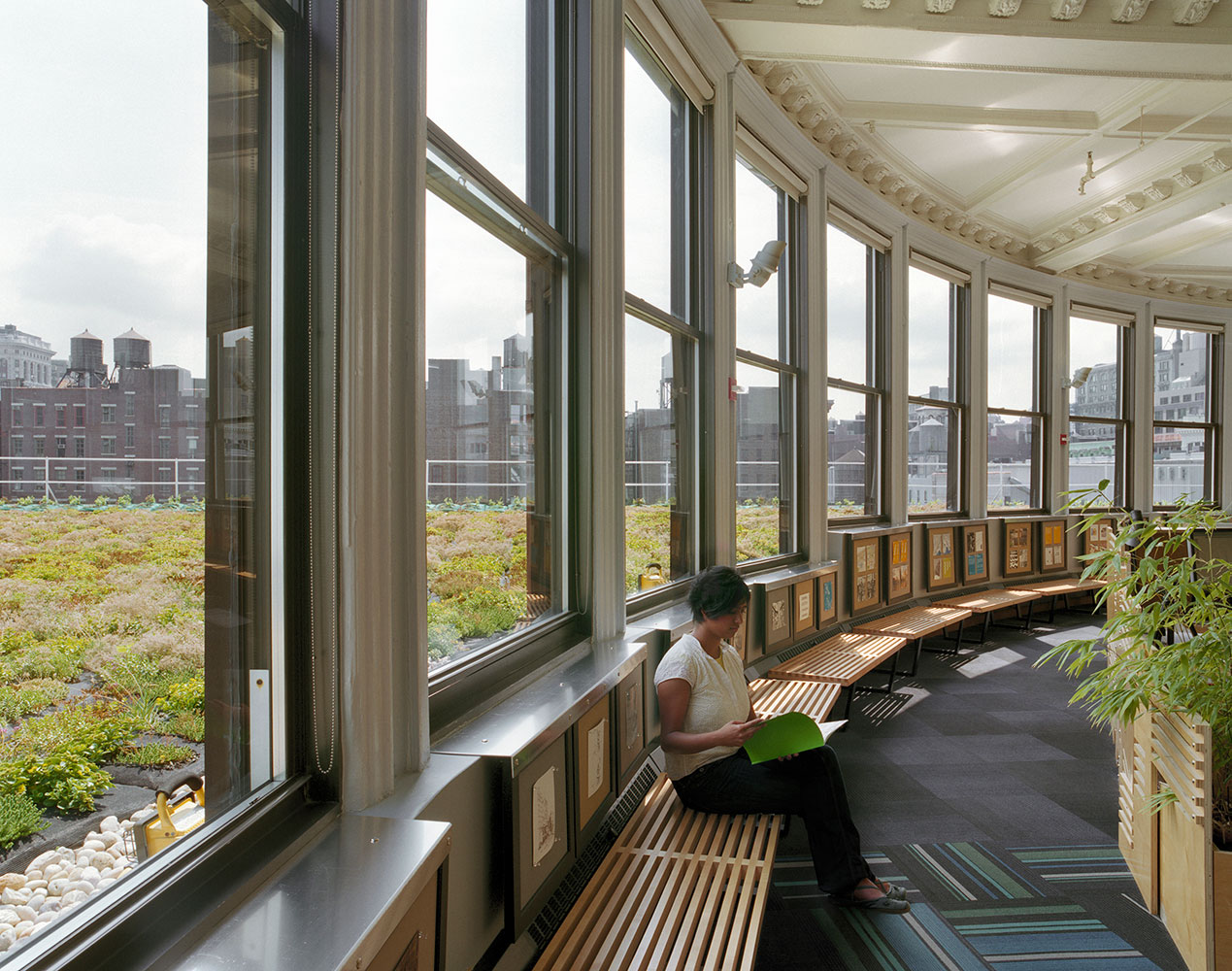
Case Study: 641 Avenue of the Americas, New York, NY
641 Avenue of the Americas (fig. 3), the former Ladies Mile department store, Simpson Crawford, had a remnant of a terrace extending from the 8th floor. Once a terracotta tiled terrace for the Palatial Restaurant of the store, the rooftop had been replaced by a black-tarred membrane. Over the years mechanical equipment took over the roof and were then left to rust, cluttering the spectacular midtown views. COOKFOX Architects transformed the interior of the penthouse into a high-performance workspace. Transforming the roof required a lightweight inexpensive, modular system. COOKFOX partnered with Green Paks and McEnroe Organic Farm to install a bag system of expanded shale and organic compost, planted with sedums, on 3,600 square feet of terrace. Within weeks the ecosystem began to grow in complexity with tiny bugs, then birds and later kestrels who hunt from the green roof. The sedums soon formed a lush colorful carpet that reduced the roof temperature by over 90-degrees Fahrenheit on a hot summer day. Volunteer plants took root from seeds deposited by birds or wind, adding to the biodiversity of the ecosystem.
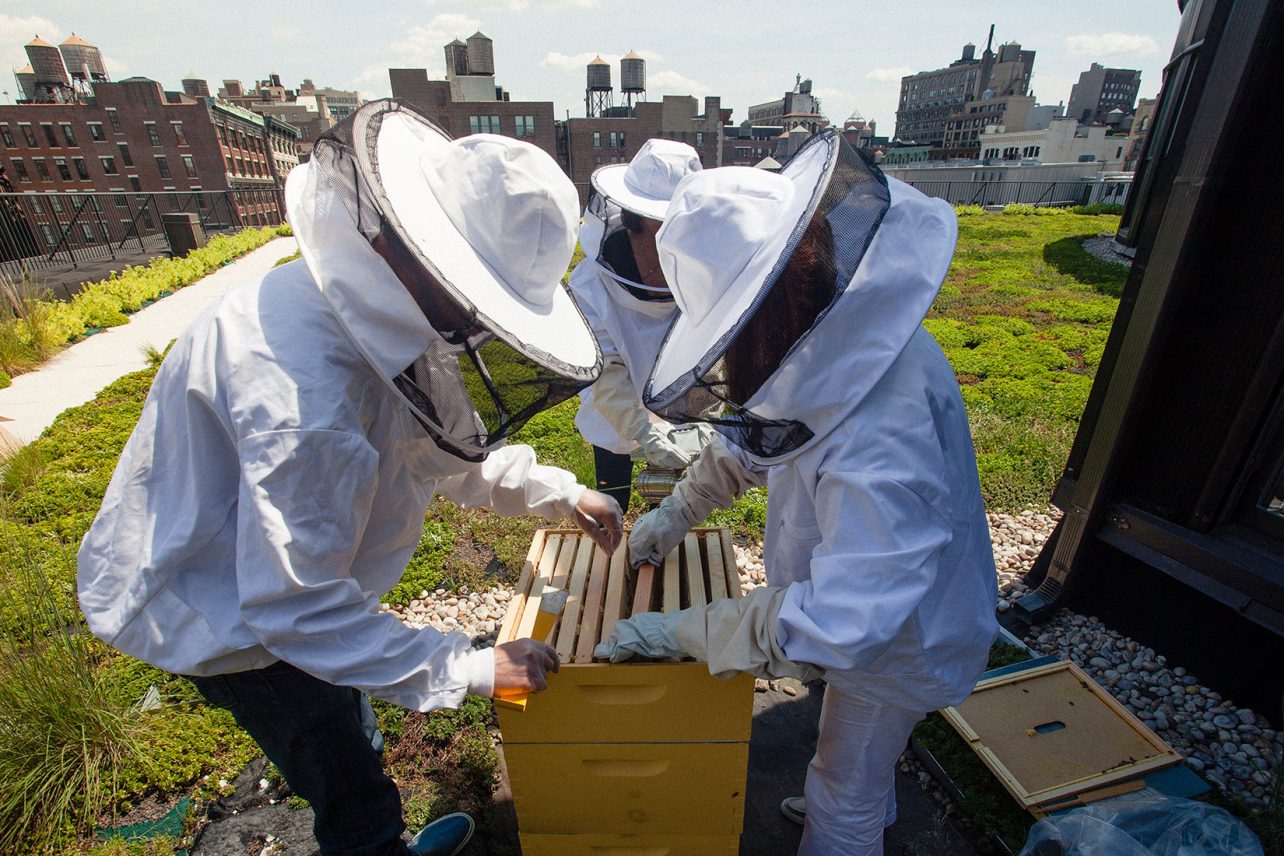
A small section of the roof was dedicated to small-scale experiments with urban farming. An apiary was introduced (fig. 4), and raised plant beds and vertical aeroponic systems produce vegetables for the studio. What began as a demonstration of an inexpensive, simple green roof system became a foothold for the revival of a fully functioning ecosystem that is integrated with the wider ecology and systems of the city. As architects who work primarily in New York City, the proximity to nature, and engagement with the natural cycles of the living roof has inspired a deepened conviction that biophilic design is not only an urban amenity, but must be a compulsory feature of healthy urban buildings.

Case Study: 150 Charles Street, New York, NY
At a new development at 150 Charles Street (fig. 5), on the site of the Whitehall Warehouse near the Hudson river in the West Village, NYC, the underlying zoning encouraged “tower-in-the-park” massing—a slender residential tower, surrounded by an open plaza. The designers sought a building more integrated with both the historic neighborhood and nature. Working closely with City Planning, the building received a special zoning permit to allow a unique massing for the site that preserved the best of the West Village streetscape, while providing new housing and vibrant green space.
The warehouse was among 14 blocks of the West Village neighborhood designated as part of the Urban Renewal Study Area in 1961. The adjacent streets were the laboratory of Jane Jacobs’ ideas, which inspired her observations and helped refine her theories. Taking on the prevailing forces of Robert Moses-era city planners, she defended the virtues of diverse, mixed use neighborhoods where daily life unfolds in an unrehearsed “ballet of the sidewalks.” Healthy cities, she argued, are places where the urban fabric continually knits itself together in an organic, spontaneous way.


Through Jacob’s legacy of community activism, these once-threatened blocks survived, and retaining the Whitehall warehouse base provided a connection to the street and the neighborhood’s past. The massing of the tower was concentrated at the interior of the site, minimizing bulk on the street. Inspired by the early 20th Century towers, particularly the Barclay Vesey, the tower was setback and sculpted to minimize intrusion into the sky plane. The resulting form created wide terraces of landscaped open space accessible from nearly every floor (fig. 6-9). In a critical negotiation, City Planning wrote a mandate for “superior landscaping” into the zoning text, which requires the owner to maintain the planted spaces for the life of the building. The resulting green roofs, planted terraces and a garden courtyard, cover fully half of the site. Each landscaped area is tuned to a particular “ecotone” or microclimate created by varying exposures to sun, wind, and rain, and is irrigated with captured rainwater, reducing the building’s use of potable water and output to the city’s storm drains. The plantings also connect residents to nature in an immediate way, ensuring healthier living spaces, and to the extent that neighbors and pedestrians interact with the landscape, the building contributes to healthier urban life.
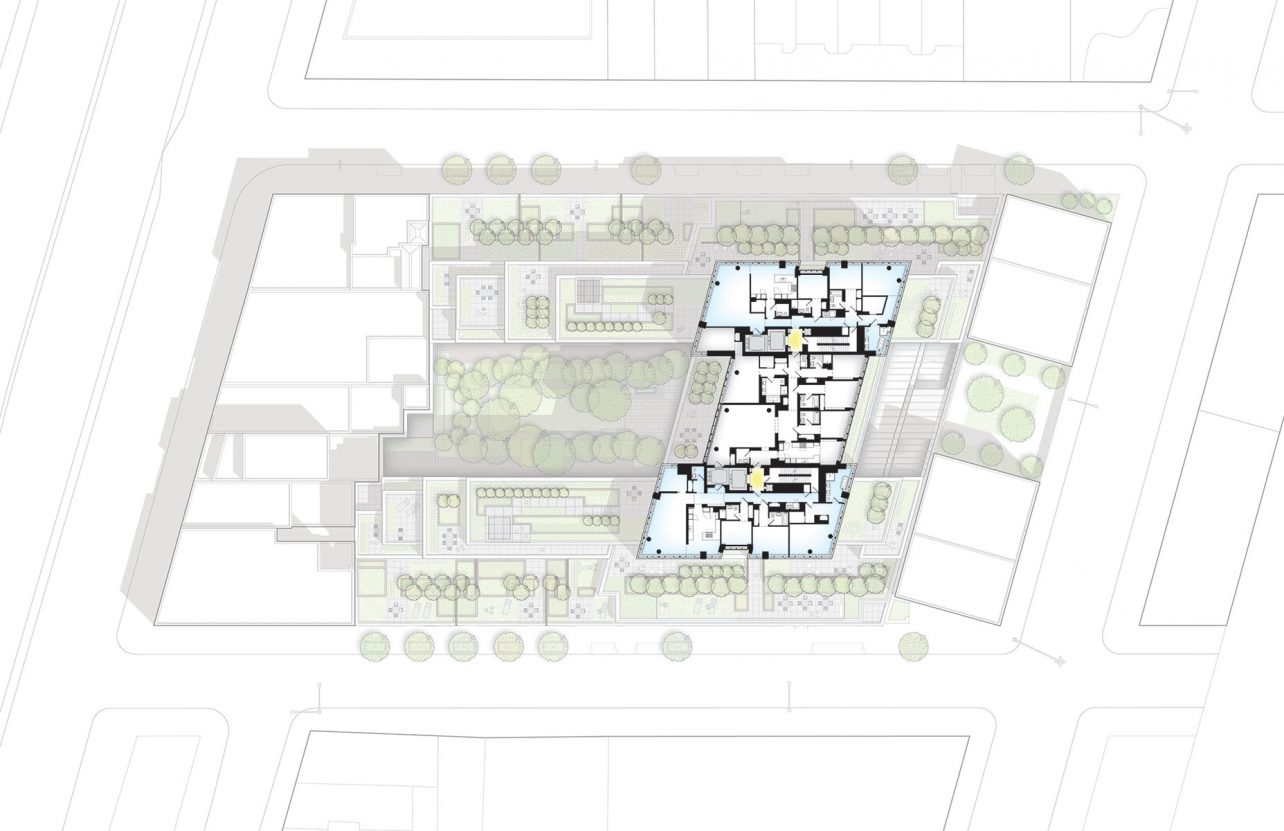

Architectural forms evolve, but the challenges facing cities to manage increasing demand on resources and infrastructure, feed themselves, and mitigate the worst of climate change effects makes it hard to imagine a future that does not prioritize planted surfaces. Some global cities such as Singapore and Washington, DC, are implementing various “green area ratio” (GAR) requirements in urban development. In New York, in the absence of strong policy to encourage planted surface, the private sector is racing ahead of policy in search of more healthful productive working and living environments. Commercial concerns of attracting top tenants, higher paying buyers and the best professional talent, are driving developers to lead the transformation of new building design to ecologically integrated forms. The developer-driven zoning amendments at 150 Charles Street represent one potential zoning pathway to integrating green space into new buildings in New York through policy.
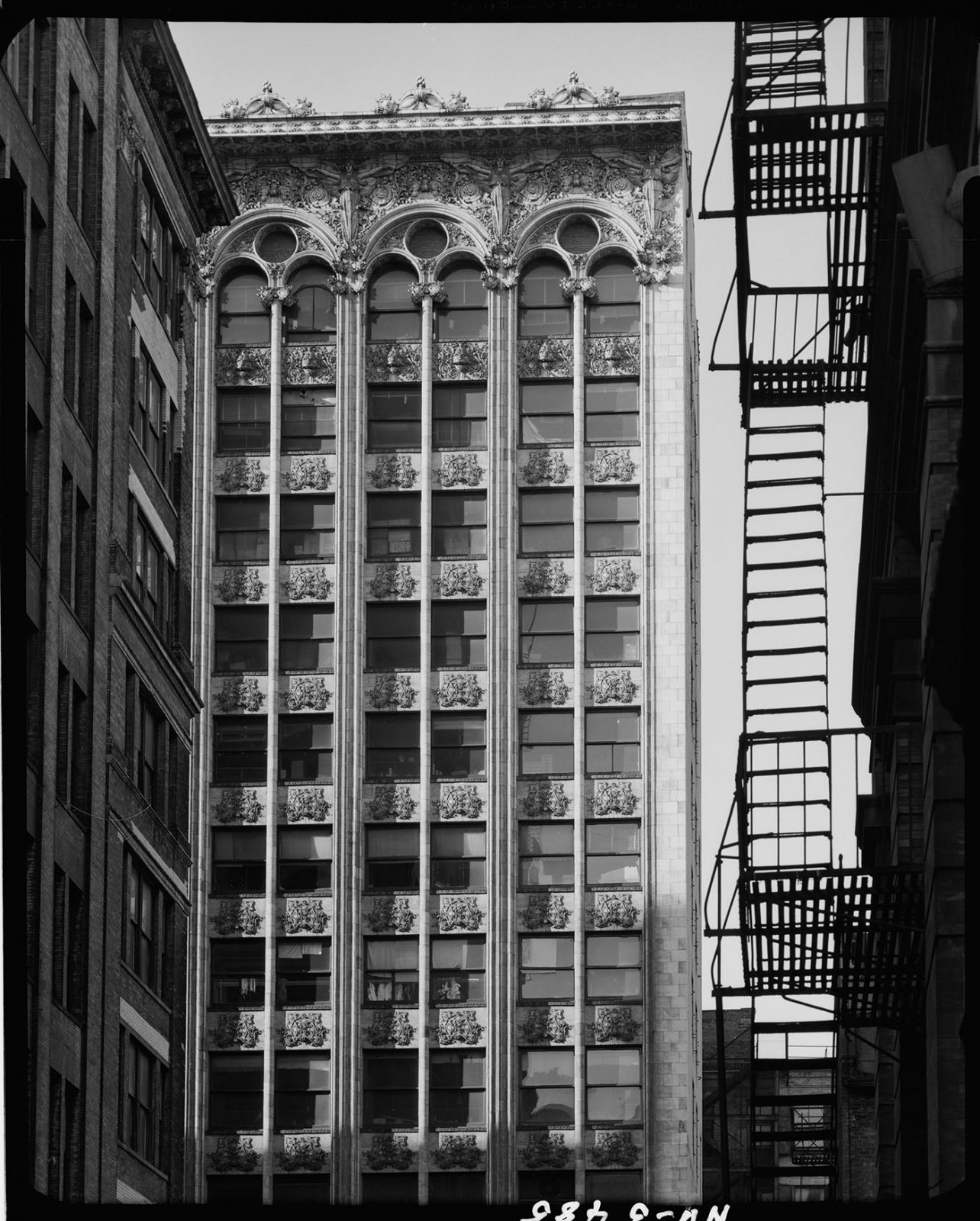
Case Study: 300 Lafayette Street, New York, NY
300 Lafayette Street (fig. 10) is an unusual void, a fragment of space left over from the confluence of Lafayette and Houston Streets. This prominent—if disjointed—intersection is the result of past planning decisions that turned Houston Street into a major traffic artery, one of Manhattan’s main cross-town routes.
In the immediate vicinity, the Bayard-Condict Building at 65 Bleeker Street (fig. 11) stands out as an example of natural analogues in architecture. The only work of American architect Louis Sullivan to be built in New York City, the building displays his fascination with natural morphology and scalable geometries, ideas that can be seen as frameworks for the evolution of skyscraper architecture. With its organic ornamentation, Bayard-Condict is a highly visible source of inspiration for the biophilic design of 300 Lafayette.
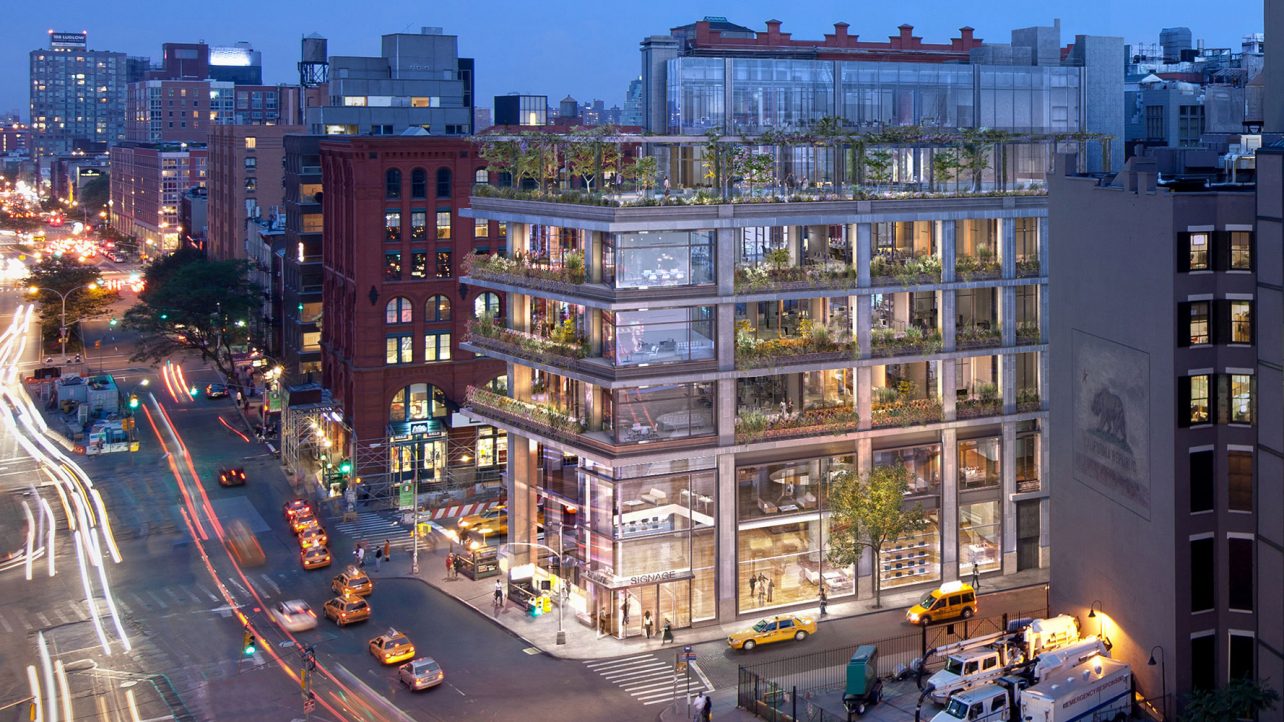
Nearby, Ernest Flagg’s “Little Singer Building” is encased with deep reveals, balconies and intricate natural analogue designs. Like Sullivan’s building, the ornately detailed drawings and ornamentation of the building are an exploration of organic and natural forms and geometries.
Today, façade technology allows a high degree of freedom from structural constraints, allowing glass and steel to be used in expressive ways to incorporate patterns and natural analogues. The façade can become an armature for either literal representations of natural forms, or more abstract biomimetic patterns, and planted environments.
At 300 Lafayette, minimal frames, green terraces and balconies of the façade are used to create articulation and depth in the façade and reconcile the transition between conflicting scales of Houston and Lafayette Street. With an open, corner location, 300 Lafayette provides an abundance of daylight to interior spaces and access to green spaces typically not available in the workplace.
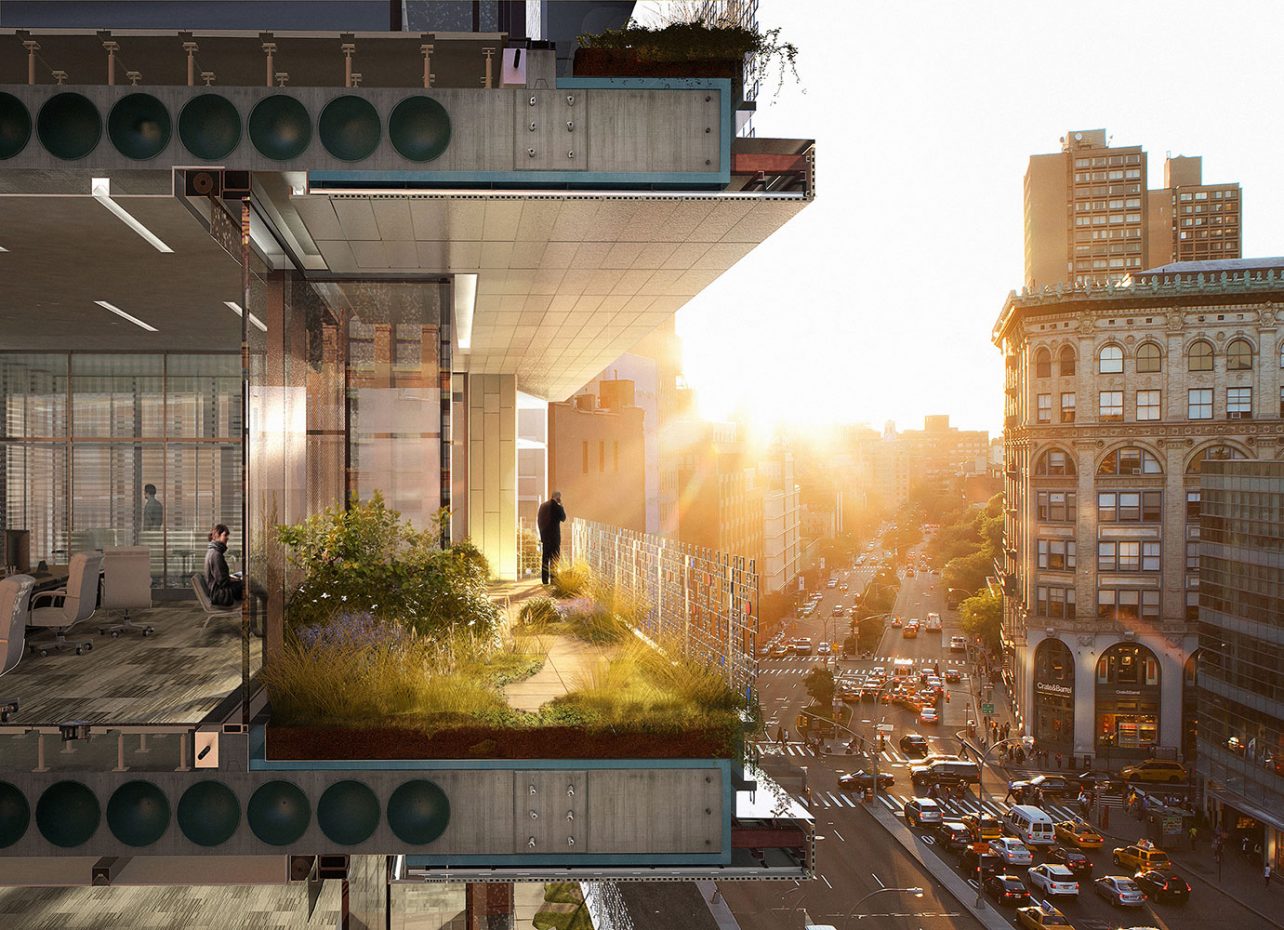
The designers turned to conservation ecologist Eric Sanderson’s research on Mannahatta (Sanderson, 2009) to imagine the possibilities for the fifth façade, distributing the site’s historic ecology across the roof and deep terraces (fig. 12). The plants provide a natural filter between the building’s occupants and the street below, framing views and softening glare from direct sunlight or light reflected from adjacent buildings. The health benefits of the planting extend to the public as new green space replaces a site dominated by concrete long dominated by car-based uses.
Architect and theorist Vincent Scully described architecture as the human response to natural typography of a place, yet the human made typography of cities cannot be disconnected from nature. “But underneath all the complexity of those urban situations the larger reality still exists: the fact of nature, and of humanity’s response to the challenge—the threat, the opportunity—that nature seems to offer in any given place.” (Scully, 1991, p. 1) Using the principles of biophilic design and applying it to buildings and urbanized land is critical to our pursuit of making a healthier, more vibrant city. In creating space for nature by reclaiming the Fifth Façade of various modern building forms, architects are employing private space for public good, while providing measurable benefits to workers and residents. Biophilic design can help foster a better understanding that shared natural resources and natural processes are a shared social responsibility. The promise of biophilic design in New York is not only a design for a better shared quality of life but a mode of survival for the 21st Century.

